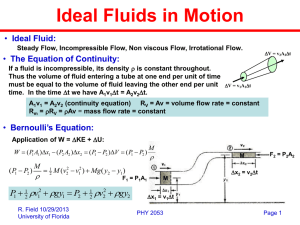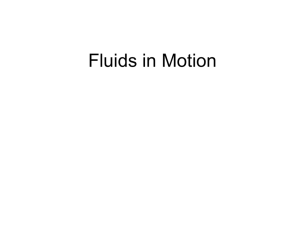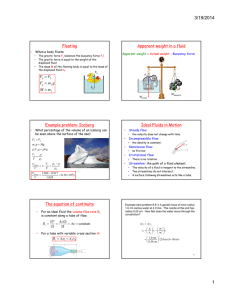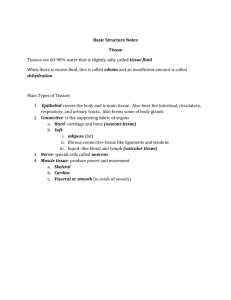Fluids
advertisement
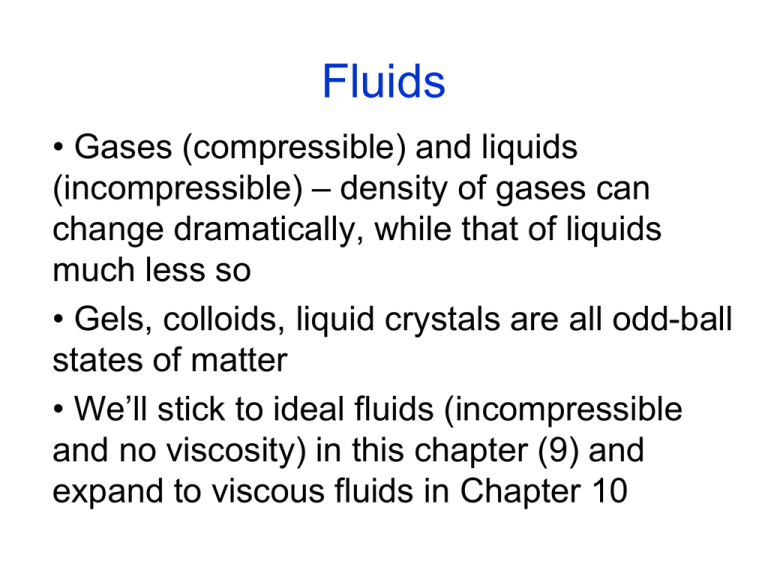
Fluids • Gases (compressible) and liquids (incompressible) – density of gases can change dramatically, while that of liquids much less so • Gels, colloids, liquid crystals are all odd-ball states of matter • We’ll stick to ideal fluids (incompressible and no viscosity) in this chapter (9) and expand to viscous fluids in Chapter 10 Pressure in a fluid • Pressure is the normal force/area acting in a fluid – in the absence of external forces a fluid is in equilibrium and the pressure will be uniform in a fluid P P P P P P • The external pressure on a confined fluid increases the pressure uniformly throughout the fluid by the same amount. This is known as Pascal's principle Hydraulic Devices • the applied pressure P = Fin/Ain Fin Fout • the output force, Fout, is determined from P = Fin/Ain = Fout/Aout • So there is an amplification of the output force F Aout F , out Ain in Middle Ear Hydraulics •a factor of 20 reduction in the effective area of the footplate of the stapes from that of the malleus • with a roughly constant force acting, the pressure is greatly increased at the stapes – leading to amplification of sound by about 20 x Problems under Pressure • Ex. 8.2 a) A cylindrical tube filled with blood is held vertically. The tube has a radius and length of 1 cm and 10 cm, respectively. Calculate the pressure at the bottom of the tube. • b) Calculate the pressure exerted on the ground by a 100 kg man standing squarely on his feet, each sole having an area of 200 cm2. Fluid Flow • Two types of fluid flow: steady flow, or time independent flow, and unsteady flow, or time dependent flow • Steady flow can also be visualized by drawing contour lines, known as streamlines Laminar vs Turbulent Flow Laminar = layered flow – used in filtered air in hospitals, for example Turbulent = random flow – important in blood flow – clotting/heart valves Conservation Laws and Fluids I • #1 - Conservation of mass • With density r, the mass in a cylinder of length vDt and cross-section area A is Dm r A1v1Dt so the volume per unit t is Av and A1 A2 v1 v2 Continuity Equation: A1v1 A2 v 2 . Conservation of Energy • Work – Energy theorem with Q = Av = constant = volume/time : Wnet = D KE 1 DKE r ( v 22 v 12 )QDt , 2 • What kinds of work are done here? A1 v1 F1 = PA1 v1 A2 F2=P2A2 v2 y1 y2 v1 F1 = PA1 A2 A1 y1 F2=P2A2 v2 y2 Bernoulli’s Equation I Wgrav DPEgrav ( r QDt ) g ( y2 y1 ), There is also work done by the pressure forces: W1 F1Dx1 P1 A1 (v1Dt ) So WP ( P1 P2 )QDt. 1 2 2 2 r v 2 v1 QDt ( P1 P2 )QDt r g ( y2 y1 )QDt Bernoulli’s Equation II 1 r v v r g ( y y ) ( P P ) 2 QDt 0 2 2 2 1 2 1 1 2 P1 r v r gy1 P2 r v r gy2 1 2 2 1 1 2 2 2 OR 1 2 P r v r gy constant 2 This is the most important equation – it represents conservation of energy Let’s now look at a bunch of applications of this Flow in a tube • If there is no height change then we have 1 2 P r v constant 2 • Aneurysm: when the crosssectional area of the blood vessel increases, the blood velocity decreases (Av = const) – when this occurs, the pressure must increase – dangerous • Atherosclerosis: when the crosssectional area decreases, the pressure drops causing the heart to work harder – perhaps leading to a cardiac event – TIA or stroke Blood Flow Problem • Suppose that a catheter is inserted into the aorta, the largest artery of the body, to measure the local blood pressure and velocity (found to be 1.4 x 104 Pa and 0.4 m/s) as well as to view the interior of the artery. If the inside diameter of the aorta is found to be 2 cm and a region of the aorta is found with a deposit due to atherosclerosis where the effective diameter is reduced by 30%, find the blood velocity through the constricted region and the blood pressure change in that region. For this problem assume that blood is an ideal fluid and take its density to be 1060 kg/m3. Flow under No Pressure Change • When P = constant Bernoulli’s equation becomes 1 2 r v r gh constant 2 • One application is the efflux velocity of a large water tank 2 1 2 r v r gy1 r gy2 2 v 2 g ( y2 y1 ) 1 Hydrostatics • In the case of statics with no flow, v = 0 and we have P r gy P r gy 1 1 2 2 • Let’s get this result from first principles: balance of forces on a slab of fluid gives F1 Fw F2 P2 A P1 A r ( Ah) g or P2 P1 r gh where h = Dy in agreement with the above • These P’s are absolute pressures • Ex. 8.7 Your blood pressure varies not only periodically in time with your heartbeat but also spatially at different heights in the body. This variation is due to differences in the weight of the effective column of blood in your blood vessels as a function of height in the body. Assuming that the average blood pressure at the heart is 13.2 kPa (corresponding to the average of a high and low pressure of 120/80, as it is commonly referred to, or 100 mm Hg- find the blood pressure at foot level (1.3 m below the heart) and at head level (0.5 m above the heart). If a person experiences an upward acceleration, as for example in an airplane during take-off or even in a rapid elevator in a tall building, the increased pressure can drain the blood from the person’s head. What is the minimum acceleration needed for this to occur (take the head to be 25 cm in Atmospheric Pressure and Gauge Pressure • With one of the pressures referenced to the atmosphere at sea level, the absolute pressure is given by P Patm r gh ; Since Patm = 1.01 x 105 Pa, this means that the weight of the column of air above a 1 m2 crosssectional area is 105 N – or since Patm = 14.7 pounds/in2, the weight of the column of air above 1 in2 is 14.7 lb. rgh is called the gauge pressure – the difference between absolute and atmospheric P Can measure pressure as a height of fluid column – Patm → 10 m water or 760 mm Hg • Ex. 8.10 Calculate the height of a column of water or mercury when a long tube closed at the bottom is filled and then inverted into an open container with the same liquid. Based on this result, what is the maximum theoretical length of a functioning straw for sucking water up, ie. above what height would it be impossible to suck water up in such a straw. Archimede’s Principle • the buoyant force on an object is equal to the weight of the fluid displaced by the object • Ex 8.9 The tallest iceberg ever measured was 168 m above sea level. Assuming it was in the shape of a large cylinder, find its depth below the surface. (Ignore the variation in the density of water or ice with depth or temperature)
